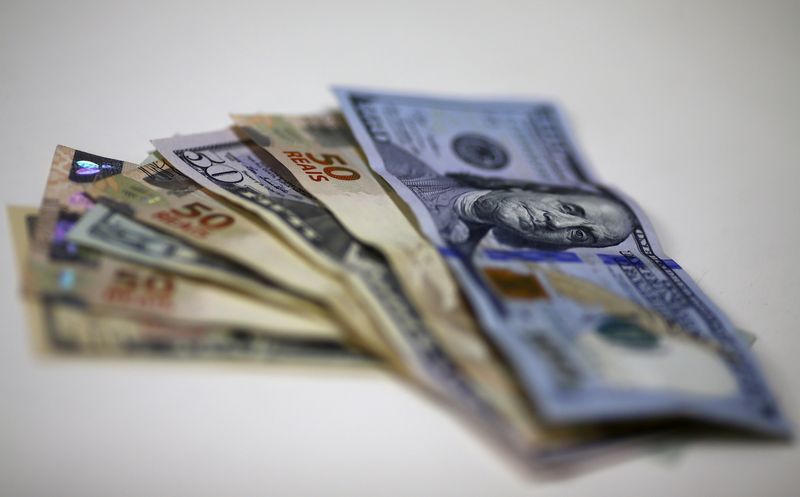Emerging FX already riding higher local rates will outperform this

© Reuters. FILE PHOTO: Brazilian Real and U.S. dollar notes are pictured at a currency exchange office in Rio de Janeiro, Brazil, in this September 10, 2015 photo illustration. REUTERS/Ricardo Moraes/File Photo
By Vuyani Ndaba and Vivek Mishra
JOHANNESBURG/BENGALURU (Reuters) – Emerging market currencies will struggle to stem losses in the near-term as the U.S. Federal Reserve lifts interest rates off the zero bound, but currencies from countries where central banks have already begun raising rates will outperform the rest.
A Reuters poll of market strategists taken Jan. 31-Feb. 3 suggests there will be no repeat of the mayhem in 2013, when the U.S. Fed’s decision to trim bond purchases punished emerging market currencies across the board.
More than 70% of respondents to an extra question – 23 of 32 – said front-loaded rate hiker currencies such as Brazil’s real and Russia’s rouble will weather the storm better than emerging market currencies did during that episode.
While those two central banks have already raised rates by 875 basis points and 425 basis points, respectively, the Fed has only cut back on its bond purchases, although is widely expected to deliver a rate rise at its March meeting.
Emerging market currencies began the year firmly, partly due to a broadly weaker dollar, with the Colombian peso, the Brazilian real and the South African rand gaining up to 5%, to top a list of 20 currencies tracked by Reuters against the dollar.
But these gains are forecast to be torpedoed in three months by an expected 25 basis point Fed hike in March, likely attracting inflows to the U.S. and keeping the mighty dollar in the driving seat.
Historically, high-risk, high-reward currencies have almost always weakened at the beginning of a Fed hiking cycle. The backdrop of a slow emergence from a deadly pandemic appears to be no exception.
“A hawkish Fed will keep EM local markets on the back foot, with rising carry likely to come into play as a major driver for currencies only later,” Jonny Goulden, emerging market strategist at JPMorgan (NYSE:), said.
“The wide range of possible outcomes from Russia-Ukraine tensions remains a significant source of two-way risk for EM assets,” he added.
(Reuters poll graphic on emerging market currencies outlook, https://fingfx.thomsonreuters.com/gfx/polling/mypmnjarbvr/Reuters%20Poll%20-%20Emerging%20market%20currencies%20outlook.png)
In the longer term, competition for capital inflows is likely to intensify as central bankers around the world reign in on rising inflation locally, with the U.S. wrestling its own quickest inflation since 1982.
Barclays (LON:) analysts wrote that in emerging markets, most central bank tightening cycles are underway and thus expectations for future rate paths are more established. Prospects for real yield should drive relative EM currency performance in the long run.
“We expect the proactive central bank tightening cycles in BRL and MXN to be rewarded with currency appreciation…
Read More: Emerging FX already riding higher local rates will outperform this
